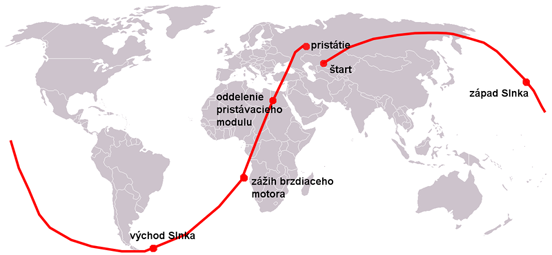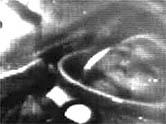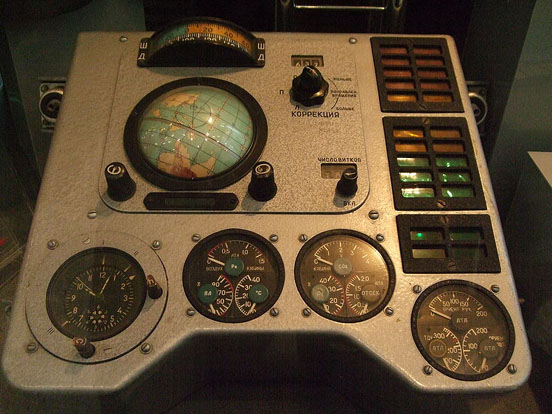 |
|
By
Wikipedia,
the free encyclopedia,
http://en.wikipedia.org/wiki/Vostok_1
Vostok 1 (Russian: Восток-1, Orient 1 or East 1) was the first human spaceflight. The Vostok 3KA spacecraft was launched on April 12, 1961, taking into space Yuri Gagarin, a cosmonaut from the Soviet Union. The Vostok 1 mission was the first time anyone had journeyed into outer space and the first time anyone had entered into orbit. The Vostok 1 was launched by the Soviet space program and designed by the Soviet rocket scientists Sergey Korolyov and Kerim Kerimov.
Crew
Backup crew
Reserve crew
Mission parameters
Mission highlights
 | |
Path of Gagarin's complete orbit; the landing point is west of takeoff point due to the eastward rotation of the Earth. |
Gagarin orbited the Earth once in 108 minutes. He returned unharmed, ejecting from the Vostok capsule 7 km (23,000 ft) above the ground and parachuting separately to the ground since the capsule's parachute landing was deemed too rough for cosmonauts to risk.
Ground controllers did not know if a stable orbit had been achieved until 25 minutes after launch.
The spacecraft attitude control was run by an automated system. Medical staff and spacecraft engineers were unsure how a human being might react to weightlessness, and therefore the pilot's flight controls were locked out to prevent Gagarin from taking manual control. (Codes to unlock the controls were placed in an onboard envelope, for Gagarin's use in case of emergency.) Vostok could not change its orbit, only spacecraft attitude (orientation), and for much of the flight the spacecraft's attitude was allowed to drift. The automatic system brought Vostok 1 into alignment for retrofire about 1 hour into the flight.
Retrofire took place off the west coast of Africa, near Angola, about 8,000 km (5,000 mi) from the desired landing place. The liquid-fueled retrorockets fired for about 42 seconds. Due to weight constraints there was no backup retrorocket engine. The spacecraft carried 10 days of provisions to allow for survival and natural decay of the orbit in the event the retrorockets failed.
After retrofire, the Vostok equipment module unexpectedly remained attached to the reentry module by a bundle of wires. The two halves of the craft were supposed to separate ten seconds after retrofire, but this did not happen until 10 minutes had passed. The spacecraft went through wild gyrations before the wires burned through and the descent module settled into the proper reentry attitude.
The FAI rules in 1961 required that a pilot must land with the spacecraft to be considered an official spaceflight for the FAI record books. At the time, the Soviet Union insisted that Gagarin had landed with the Vostok and the FAI certified the flight. Years later, it was revealed that Gagarin had ejected and landed separately from the Vostok descent module.
When Soviet officials filled out the FAI papers to register the flight of Vostok 1, they stated that the launch site was Baykonur at 47°22′00″N 65°29′00″E / 47.366667°N 65.483333°E / 47.366667; 65.483333. In reality, the launch site was near Tyuratam at 45°55′12.72″N 63°20′32.32″E / 45.9202°N 63.3423111°E / 45.9202; 63.3423111, 250 km (160 mi) to the south west of "Baykonur". They did this to try to keep the location of the Space Center a secret. In 1995, Russian and Kazakh officials renamed Tyuratam Baikonur.
The re-entry capsule is now on display at the museum of RKK Energiya in Korolyov.
Officially the U.S. congratulated Russia on its accomplishments.
Mission timeline
 | |
Yuri Gagarin in Vostok 1 |
- Wednesday, April 12, 1961 Minutes before his launch, Yuri Gagarin recorded this statement, "Dear friends, known and unknown to me, my dear compatriots and all people of the world! Within minutes from now, a mighty Soviet rocket will boost my ship into the vastness of outer space. What I want to tell you is this. My whole life is now before me as a single breathtaking moment. I feel I can muster up my strength for successfully carrying out what is expected of me."
- Countdown begins Yuri Gagarin is in the Vostok 1 spacecraft on the launchpad. His television picture appears on television screens in the launch control room from an onboard television camera. Sergey Korolyov speaks into a microphone: "Zarya calling Kedr (Gagarin's call sign). The countdown is about to start." Gagarin replied, "Roger. Feeling fine, excellent spirits, ready to go."
- 06:07 UTC Launch occurs from the Baikonur Cosmodrome Site No.1; after Gagarin's flight that launch pad became known as Gagarin's Start. At ignition and liftoff, Sergey Korolyov radios, "Preliminary stage..... intermediate..... main..... LIFT OFF! We wish you a good flight. Everything is all right." Gagarin replies, "Poyekhali! (Off we go!)."
- 06:09 UTC Two minutes into the flight and the four strap-on booster sections of the Vostok rocket have used up the last of their propellant, they shut down and drop away from the core vehicle. (T+ 119 s)
- 06:10 UTC The payload shroud covering Vostok 1 is released, this uncovers the window at Gagarin's feet with the optical orientation device Vzor (lit. "eye"). (T+ 156 s)
- 06:12 UTC Five minutes into the flight and the Vostok rocket core stage has used up its propellant, shuts down and falls away from the Vostok spacecraft and final rocket stage. The final rocket stage ignites to continue the journey to orbit. (T+ 300 s)
- 06:13 UTC The rocket is still firing, pushing Vostok 1 toward orbit. Gagarin reports, " .. the flight is continuing well. I can see the Earth. The visibility is good. ... I almost see everything. There's a certain amount of space under cumulus cloud cover. I continue the flight, everything is good."
- 06:14 UTC The rocket continues to fire, starting to pass over central Russia now. Gagarin reports, "Everything is working very well. All systems are working. Let's keep going!"
- 06:15 UTC Three minutes into the burn of the final rocket stage and Gagarin reports, "Zarya-1, Zarya-1, I can't hear you very well. I feel fine. I'm in good spirits. I'm continuing the flight..." Vostok 1 is moving further downrange from the Baikonur Cosmodrome. He is reporting back to Zarya-1 (the Baikonur ground station) and must be starting to move out of radio range of that station.
- 06:17 UTC The Vostok rocket final stage shuts down, ten seconds later the spacecraft separates and Vostok 1 reaches orbit. (T+ 676 s) Gagarin reports, "The craft is operating normally. I can see Earth in the view port of the Vzor. Everything is proceeding as planned". Vostok 1 passes over Russia and moves on over Siberia.
 | |
Part of the Vostok 1 control panel |
- 06:21 UTC Vostok 1 passes over the Kamchatka peninsula and out over the North Pacific Ocean. Gagarin radios, "...the lights are on on the descent mode monitor. I'm feeling fine, and I'm in good spirits. Cockpit parameters: pressure 1; humidity 65; temperature 20; pressure in the compartment 1; first automatic 155; second automatic 155; pressure in the retro-rocket system 320 atmospheres..."
- 06:25 UTC As Vostok 1 begins its diagonal crossing of the Pacific Ocean from Kamchatka peninsula to the southern tip of South America, Gagarin asks, "What can you tell me about the flight? What can you tell me?". He is requesting information about his orbital parameters. The ground station at Khabarovsk reports back, "There are no instructions from No. 20 (Sergey Korolyov), and the flight is proceeding normally" They are telling Gagarin that they don't have his orbital parameters yet because the spacecraft has been in orbit for only 6 minutes, but the spacecraft systems are performing well.
- 06:31 UTC Gagarin transmits to the Khabarovsk ground station, "I feel splendid, very well, very well, very well. Give me some results on the flight!". Vostok 1 is nearing the VHF radio horizon for Khabarovsk and they respond, "Repeat. I can't hear you very well". Gagarin transmits again, "I feel very good. Give me your data on the flight!" Vostok 1 passes out of VHF range of the Khabarovsk ground station and contact is lost.
- 06:37 UTC Vostok 1 continues on its journey as the Sun sets over the North Pacific. Gagarin crosses into night, northwest of the Hawaiian Islands. Out of VHF range with ground stations, communications must now take place via HF radio.
- 06:46 UTC Khabarovsk ground station sends the message "KK" via telegraph (on HF radio to Vostok 1). This message means, "Report the monitoring of commands." They were asking Gagarin to report when the spacecraft automated descent system had received its instructions from the ground control. Gagarin reported back at 06:48 UTC.
- 06:48 UTC Vostok 1 crosses the equator at about 170° West, traveling in a south east direction and begins crossing the South Pacific. Gagarin transmits over HF radio, "I am transmitting the regular report message: 9 hours 48 minutes (Moscow Time), the flight is proceeding successfully. Spusk-1 is operating normally. The mobile index of the descent mode monitor is moving. Pressure in the cockpit is 1; humidity 65; temperature 20; pressure in the compartment 1.2 ... Manual 150; First automatic 155; second automatic 155; retro rocket system tanks 320 atmospheres. I feel fine..."
- 06:49 UTC Gagarin reports he is on the night side of the Earth.
- 06:51 UTC Gagarin reports the sun-seeking attitude control system had been switched on. The sun-seeking attitude control system is used to orient Vostok 1 for retrofire. The automated orientation system consisted of two redundant systems: an automatic/solar orientation system and a manual/visual orientation system. Either system could operate the two redundant cold nitrogen gas thruster systems, each with 10 kg (22 lb) of gas.
- 06:53 UTC The Khabarovsk ground station sends Gagarin the following message via HF radio, "By order of No.33 (General Nikolai Kamanin) the transmitters have been switched on, and we are transmitting this: the flight is proceeding as planned and the orbit is as calculated." They are telling Gagarin that Vostok 1 is in a stable orbit. He acknowledges the message.
- 06:57 UTC Vostok 1 is over the South Pacific between New Zealand and Chile when Gagarin sends this message, "...I'm continuing the flight, and I'm over America. I transmitted the telegraph signal "ON".
- 07:00 UTC Vostok 1 crosses the Strait of Magellan at the tip of South America. News of the Vostok 1 mission is broadcast on Radio Moscow.
- 07:04 UTC Gagarin sends spacecraft status message, similar to the one sent at 06:48. The message is not received by ground stations.
- 07:09 UTC Gagarin sends spacecraft status message, the message is not received by ground stations.
- 07:10 UTC Passing over the South Atlantic, the Sun rises and Vostok 1 is in daylight again. Vostok 1 is 15 minutes from retrofire.
- 07:13 UTC Gagarin sends spacecraft status message, similar to the one sent at 06:48. Moscow picks up this partial message from Gagarin, "I read you well. The flight is going..."
- 07:18 UTC Gagarin sends spacecraft status message, the message is not received by ground stations.
- 07:23 UTC Gagarin sends spacecraft status message, the message is not received by ground stations.
- 07:25 UTC Vostok 1 is in retrofire attitude. The retros are fired for about 42 seconds as the spacecraft nears Angola on the west coast of Africa. Retrofire takes place about 8,000 km (5,000 mi) from the planned landing point in Russia.
- 07:25 to 07:35 UTC Ten seconds after retrofire, commands are sent to separate the Vostok service module from the reentry module (sharik). One bundle of wires fails to release and the two sections of the spacecraft remain attached for another 10 minutes. Vostok 1 crosses the west coast of Africa and continues over central Africa heading towards Egypt.
- 07:35 UTC The two halves of the spacecraft begin reentry and go through wild gyrations as Vostok 1 nears Egypt. Finally, the wire bundle burns through and releases the reentry module. Gagarin telegraphs "Everything is OK" despite continuing gyrations; he later reported that he did not want to "make noise" as he had (correctly) reasoned that the gyrations did not endanger the mission (apparently due to the spherical shape of the reentry module).
- 07:35 to 07:55 UTC Reentry continues over Egypt and out over the Mediterranean, near the west coast of Cyprus and then central Turkey. Continuing to drop lower, Vostok 1 crosses back into the Soviet Union on the Black Sea coast near Krasnodar. Gagarin experiences 8 g's (Gagarin's own report states "over 10 g's") during reentry but remains conscious.
- 07:55 UTC Vostok 1 is still 7 km from the ground. The hatch is released and two seconds later Gagarin ejects from Vostok 1. At 2.5 km (8,200 ft) altitude, the main parachute is deployed from the Vostok spacecraft. The Vostok 1 lands at 07:55 UTC. Two schoolgirls witness the Vostok landing and described the scene: "It was a huge ball, about two or three metres high. It fell, then it bounced and then it fell again. There was a huge hole where it hit the first time."
- 08:05 UTC Gagarin, because his parachute opened at a much higher altitude than Vostok 1 (7 km (23,000 ft) vs. 2.5 km), lands about 10 minutes after his spacecraft. Both he and the spacecraft land via parachute 26 km (16 mi) south west of Engels, in the Saratov region at 51°16′49″N 45°58′36″E / 51.280383°N 45.976740°E / 51.280383; 45.976740. A farmer and her daughter observed the strange scene of a figure in a bright orange suit with a large white helmet landing near them by parachute. Gagarin later recalled, "When they saw me in my space suit and the parachute dragging alongside as I walked, they started to back away in fear. I told them, don't be afraid, I am a Soviet like you, who has descended from space and I must find a telephone to call Moscow!".
See also
External links
Text from Wikipedia is available under the Creative Commons Attribution/Share-Alike License; additional terms may apply.
Published in July 2009.
Click here to read more articles related to aviation and space!
|
 |



